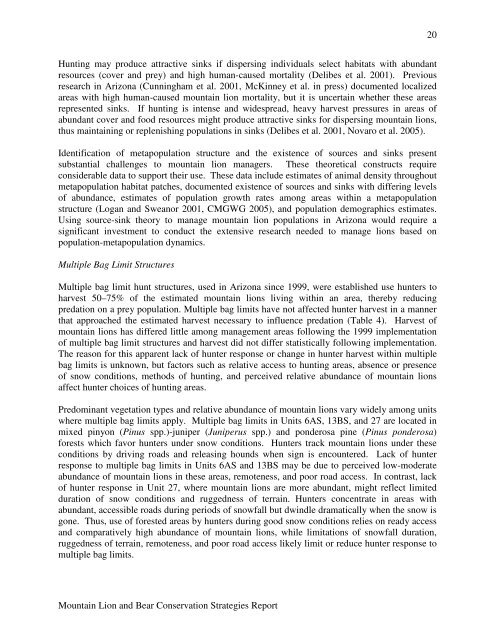Mountain Lion and Bear Conservation Strategies Report, AGFD, Jan ...
Mountain Lion and Bear Conservation Strategies Report, AGFD, Jan ...
Mountain Lion and Bear Conservation Strategies Report, AGFD, Jan ...
You also want an ePaper? Increase the reach of your titles
YUMPU automatically turns print PDFs into web optimized ePapers that Google loves.
Hunting may produce attractive sinks if dispersing individuals select habitats with abundant<br />
resources (cover <strong>and</strong> prey) <strong>and</strong> high human-caused mortality (Delibes et al. 2001). Previous<br />
research in Arizona (Cunningham et al. 2001, McKinney et al. in press) documented localized<br />
areas with high human-caused mountain lion mortality, but it is uncertain whether these areas<br />
represented sinks. If hunting is intense <strong>and</strong> widespread, heavy harvest pressures in areas of<br />
abundant cover <strong>and</strong> food resources might produce attractive sinks for dispersing mountain lions,<br />
thus maintaining or replenishing populations in sinks (Delibes et al. 2001, Novaro et al. 2005).<br />
Identification of metapopulation structure <strong>and</strong> the existence of sources <strong>and</strong> sinks present<br />
substantial challenges to mountain lion managers. These theoretical constructs require<br />
considerable data to support their use. These data include estimates of animal density throughout<br />
metapopulation habitat patches, documented existence of sources <strong>and</strong> sinks with differing levels<br />
of abundance, estimates of population growth rates among areas within a metapopulation<br />
structure (Logan <strong>and</strong> Sweanor 2001, CMGWG 2005), <strong>and</strong> population demographics estimates.<br />
Using source-sink theory to manage mountain lion populations in Arizona would require a<br />
significant investment to conduct the extensive research needed to manage lions based on<br />
population-metapopulation dynamics.<br />
Multiple Bag Limit Structures<br />
Multiple bag limit hunt structures, used in Arizona since 1999, were established use hunters to<br />
harvest 50–75% of the estimated mountain lions living within an area, thereby reducing<br />
predation on a prey population. Multiple bag limits have not affected hunter harvest in a manner<br />
that approached the estimated harvest necessary to influence predation (Table 4). Harvest of<br />
mountain lions has differed little among management areas following the 1999 implementation<br />
of multiple bag limit structures <strong>and</strong> harvest did not differ statistically following implementation.<br />
The reason for this apparent lack of hunter response or change in hunter harvest within multiple<br />
bag limits is unknown, but factors such as relative access to hunting areas, absence or presence<br />
of snow conditions, methods of hunting, <strong>and</strong> perceived relative abundance of mountain lions<br />
affect hunter choices of hunting areas.<br />
Predominant vegetation types <strong>and</strong> relative abundance of mountain lions vary widely among units<br />
where multiple bag limits apply. Multiple bag limits in Units 6AS, 13BS, <strong>and</strong> 27 are located in<br />
mixed pinyon (Pinus spp.)-juniper (Juniperus spp.) <strong>and</strong> ponderosa pine (Pinus ponderosa)<br />
forests which favor hunters under snow conditions. Hunters track mountain lions under these<br />
conditions by driving roads <strong>and</strong> releasing hounds when sign is encountered. Lack of hunter<br />
response to multiple bag limits in Units 6AS <strong>and</strong> 13BS may be due to perceived low-moderate<br />
abundance of mountain lions in these areas, remoteness, <strong>and</strong> poor road access. In contrast, lack<br />
of hunter response in Unit 27, where mountain lions are more abundant, might reflect limited<br />
duration of snow conditions <strong>and</strong> ruggedness of terrain. Hunters concentrate in areas with<br />
abundant, accessible roads during periods of snowfall but dwindle dramatically when the snow is<br />
gone. Thus, use of forested areas by hunters during good snow conditions relies on ready access<br />
<strong>and</strong> comparatively high abundance of mountain lions, while limitations of snowfall duration,<br />
ruggedness of terrain, remoteness, <strong>and</strong> poor road access likely limit or reduce hunter response to<br />
multiple bag limits.<br />
<strong>Mountain</strong> <strong>Lion</strong> <strong>and</strong> <strong>Bear</strong> <strong>Conservation</strong> <strong>Strategies</strong> <strong>Report</strong><br />
20
















